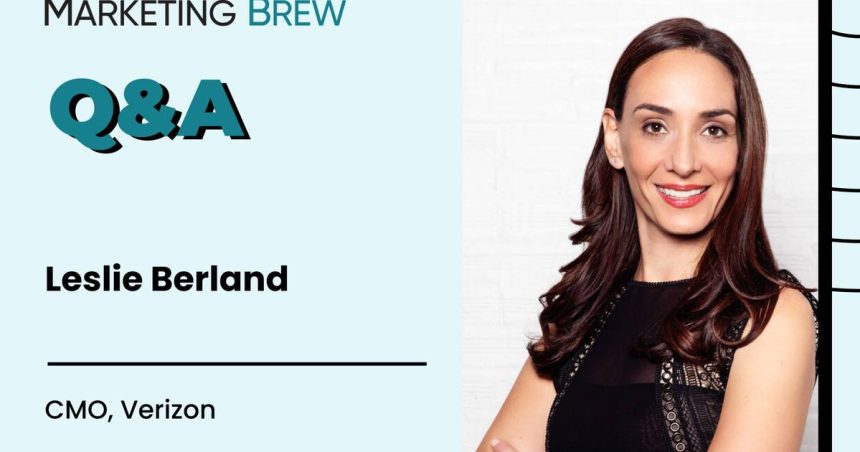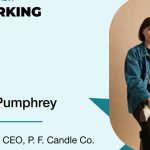Leslie Berland knows a thing or two about a rebrand.
As Twitter’s first-ever chief marketing officer nearly a decade ago, she crafted the platform’s brand identity beginning in 2016. After leaving the company in 2022 and spending about a year at Peloton, she started as Verizon’s chief marketing officer in January, where she worked on the brand’s refresh unveiled in late June.
“It was clear and apparent that there was a massive opportunity for us to rebuild a brand that was a powerful reflection of the company as it is today and really where the company is going,” she told us.
Marketing Brew asked Berland about her experience in the C-suite, how companies can avoid overcomplicating things for consumers, and how a telecommunications company can endear itself to its customers—namely, by offering them free tickets to big events like NFL games.
This interview has been edited for clarity and length.
You joined Verizon in January. Talk to me about the rebrand. Was this underway when you got there?
It was not underway before I got to the company…When I entered the company and took a step back and looked at the brand and looked at the research and customer perceptions of the brand—on the B2B side and on the consumer side—it was clear and apparent that there was a massive opportunity for us to build and rebuild a brand that was a powerful reflection of the company as it is today and really where the company is going.
What was the customer perception?
It’s a fascinating marketing challenge…Verizon is a leading brand. It has a 99% awareness in this country. It is known for being trusted and reliable, which is a dream for any brand, big or small, and there’s a lot of weight in that.
When looking at the customer research, though, we saw something really interesting. Verizon, and what we do most of the time, is invisible to people. But we touch everything within people’s lives—how they live, how they work, how they play. You really don’t see it, and you don’t feel it. It just works…When you’re at home, when you’re on the road, when you’re traveling, when you’re at work, Verizon is really powering your life.
What we found in the research is there’s sort of this invisible nature to what we enable and what we create. There was a distance between us and our customers. There’s sort of a gap between what we do and the role we play in people’s lives, and what our customers are thinking about us and whether or not they’re thinking about us.
We have been known as a telco brand, right? And really, what’s clear to us is that we’re a life brand, and that’s a very different way of showing up, that’s a very different way of communicating, and that’s a very different way of expressing ourselves. That gap was very apparent.
The company unveiled a new offering called Verizon Access, offering customers things like access to NFL games and VIP experiences. That’s very AmEx, where you worked before joining Twitter.
What we’re providing through Verizon Access is something that the company has focused on over the years. There was a program over the last couple of years that enabled and created these experiences for customers, but nobody knew about it. It had very, very low awareness…We rebranded it, there was a repositioning of it, and certainly, it’s something we’re going to be putting much more at the forefront.
Get marketing news you’ll actually want to read
Marketing Brew informs marketing pros of the latest on brand strategy, social media, and ad tech via our weekday newsletter, virtual events, marketing conferences, and digital guides.
Why does my cell-phone provider—which I view almost as a utility—need to offer its customers something like tickets to a concert? What does that give you?
When you talk about it as a utility, what we provide and what we power is so much embedded in music, sports, and entertainment, and what you’re watching on TV, what you’re doing on the internet, what you’re streaming through your phone. Our technology and our network actually powers stadiums…If you love sports, you’re going to love what we’re offering through Sunday Ticket. You’re going to love what we do in stadium, and we’re going to give you special access that is just for Verizon customers.
How powerful is that as a sales strategy?
We want to deepen the loyalty and emotional connection that our current customers have with the company and what we do, and we want to reach new audiences. We want to reach people who we haven’t yet touched. And so it is very clear and apparent that when you offer this type of value and this type of experience, it definitely drives loyalty, and it drives a connection to the brand that is deeper.
You were Twitter’s first CMO. How is marketing a platform like Twitter different from a telco?
There are similarities in that this is all about connection, communication, and conversation at both companies. At Twitter, it’s very much an open platform, a very public platform, a very visible platform…versus the challenge at Verizon, which is, we power the ability to even use Twitter on your phone, but we’re very much behind the scenes. There’s a significant difference there.
I think the most important thing to focus on is: What is the role that you play in other people’s lives? What do they love and care about the most?
How do you not overcomplicate things? If I’m paying for a wireless service, how do I manage all of these add-ons, like a streaming bundle, or access to events? How do you not overload the customer?
This is a journey that we’re on. The brand reset was much more than just a change in our look and feel…I think we’re getting better and better at this every day, to achieve what you’re describing, which is more simplicity in our messaging so that customers don’t get overwhelmed.
You want to enable customers to have choice and customization, but when we explain it, it needs to be simple and clear…You mentioned AmEx; when you have companies that have so many offerings, and so many things that we provide—I mean, there’s a ton at Verizon that I never knew existed before I joined the company. That’s a part of the marketing challenge.
Here’s my obligatory AI question. How is your team using it today?
We’re using it across the board, and our agencies are using it in lots of different ways, from research to creative development to copy development to design to targeting and beyond. Even in the brand relaunch, we started playing with AI in bolder ways in some of our creative…There continues to be a lot of opportunity here for us, but we want to be really intentional about it, obviously, and take great care.
Read the full article here








